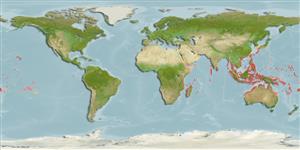Environment / Climate / Range
Ecology
Marine; freshwater; brackish; reef-associated; catadromous (Ref. 46888); depth range 0 - 3 m (Ref. 86942). Tropical, preferred 28°C (Ref. 107945); 35°N - 32°S, 28°E - 135°W
Indo-Pacific: Red Sea south to Transkei, South Africa (Ref. 4393) and east to the Hawaiian and Marquesan islands, north to southern Japan, south to New Caledonia and Norfolk Island (Ref. 8879) and Tuamotu Islands (Ref. 90102).
Size / Weight / Age
Maturity: Lm ? range ? - ? cm
Max length : 60.0 cm TL male/unsexed; (Ref. 9710); common length : 40.0 cm TL male/unsexed; (Ref. 5450); max. published weight: 8.0 kg (Ref. 37816)
Dorsal
spines
(total): 4 - 5;
Dorsal
soft rays
(total): 8-9;
Anal
spines: 3;
Anal
soft rays: 8 - 10. Bluish brown or green dorsally; flanks and abdomen silvery; dusky spots on upper row of scales, giving indistinct longitudinal stripes (Ref. 9812). Dorsal and upper lobe of caudal fin with dark-blue tip. Anal, pelvic, and pectoral fins yellow. Pectorals also with dark blue spot dorsally at origin (Ref. 9812). Pectoral-fin axil scale very long.
Inhabit coastal waters but enters estuaries and rivers where they feed on microalgae, filamentous algae, forams, diatoms, and detritus associated with sand and mud (Ref. 9812). Form schools. Oviparous, eggs are pelagic and non-adhesive (Ref. 205). Also caught using stakenets, barrier nets, and pouch nets during spawning; also taken as bycatch (Ref. 9812). Marketed fresh and perhaps salted, boiled (Thailand), canned or frozen (Australia); roe salted (Ref. 9812).
Life cycle and mating behavior
Maturity | Reproduction | Spawning | Eggs | Fecundity | Larvae
Myers, R.F., 1991. Micronesian reef fishes. Second Ed. Coral Graphics, Barrigada, Guam. 298 p. (Ref. 1602)
IUCN Red List Status (Ref. 115185)
CITES (Ref. 94142)
Not Evaluated
Threat to humans
Harmless
Human uses
Fisheries: commercial
More information
Common namesSynonymsMetabolismPredatorsEcotoxicologyReproductionMaturitySpawningFecundityEggsEgg development
ReferencesAquacultureAquaculture profileStrainsGeneticsAllele frequenciesHeritabilityDiseasesProcessingMass conversion
Tools
Special reports
Download XML
Internet sources
